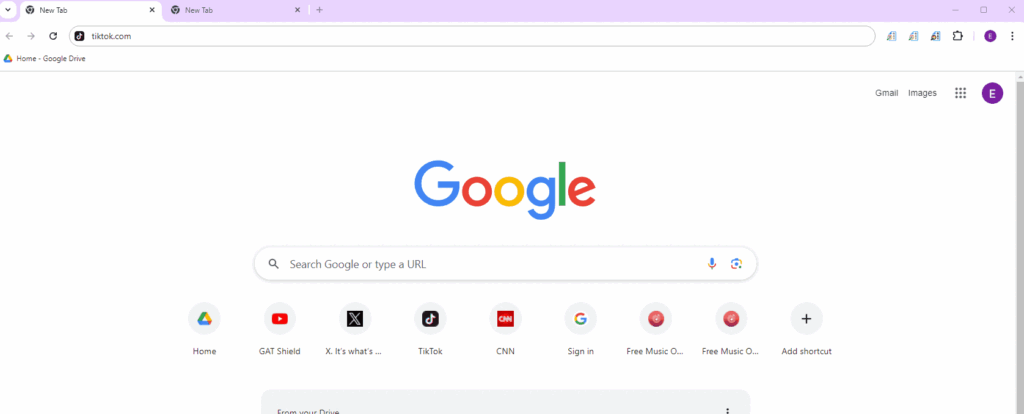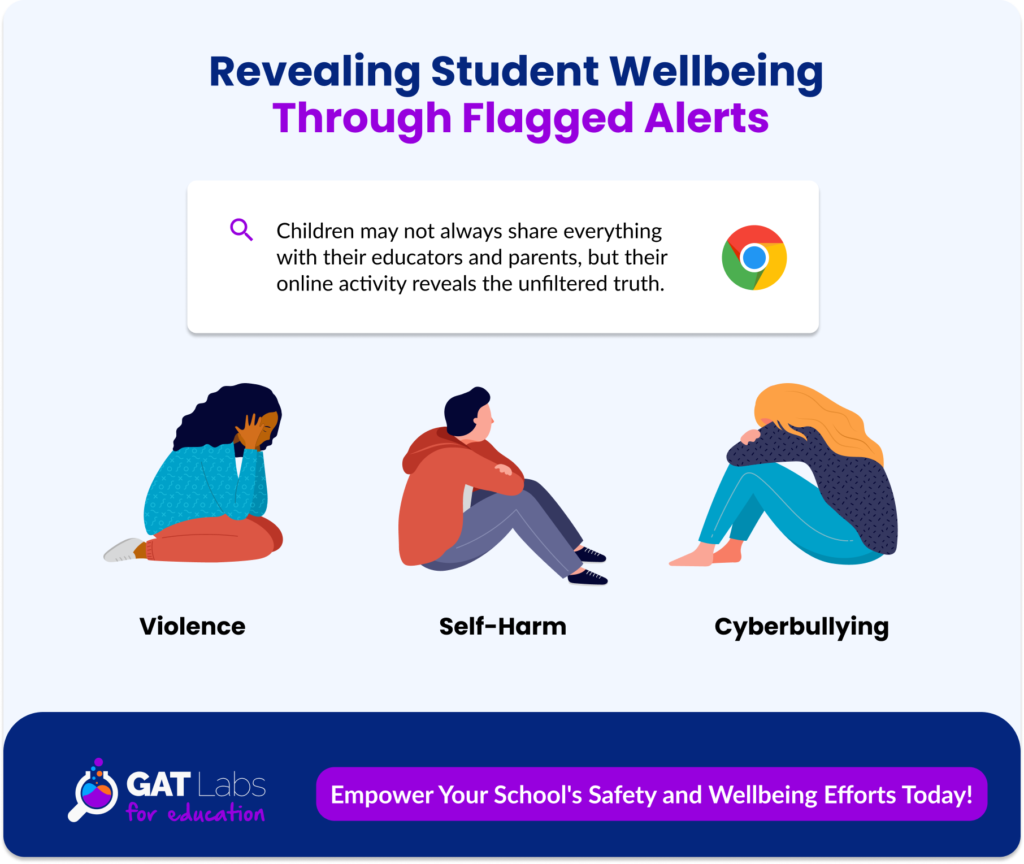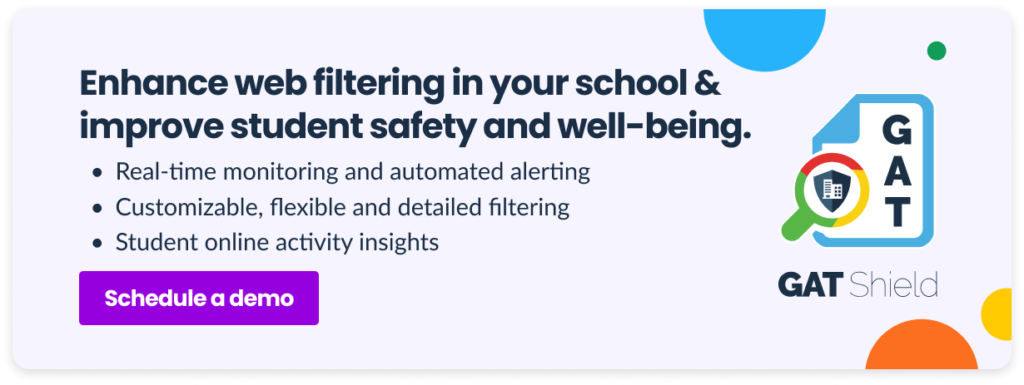Psychologists and teachers sound the alarm – well-being in schools is a real concern. Today, the style of virtual classroom management must be oriented toward preventing and reacting appropriately to risks to student mental health in Google Classroom and beyond.
In order to effectively address this need, ask yourself, Google admin, and decision-makers at your school the following questions and check our solutions.
- ▪️ Are we monitoring student misbehavior online in real time?
- ▪️ Are we filtering harmful online content in the school domain?
- ▪️ Are we following good cybersecurity practices in our school?
- ▪️ Are we offering mental health support online for students?

1. Are we monitoring student misbehavior online in real time?
Managing student behavior is crucial to thrive in the digital classroom. Kids are still kids and need clear rules on how to behave in class. Have you ever wondered how it is possible to monitor the activity of ALL students at the same time and how to get the most value out of it? Let’s find out together.
💡 Solution 1. Disturbing Online Behavior Detection with Real-time Alerts
Automated, real-time monitoring tools help quickly identify and handle disruptive student behavior online.
Solutions integrated with Google Workspace for Education, like GAT Shield, can detect concerning activity in student accounts, Chrome browsers, and the entire school domain. They search for keywords related to illegal products and activities, mental health issues, and other risks to minors.
With these alerts, admins and teachers can automatically get notifications when an improper or harmful activity has been detected and take action. Otherwise, they would need to constantly check every student’s activity in Google Classroom.
This will bear fruit in the long run, improving student academic performance and well-being. It will also ease the burden on teachers so that they can finally focus completely on teaching!
💡 Solution 2. Bad Language and Hate Speech Monitoring
Cyberbullying, cyberstalking, and privacy violations are increasingly common in schools, and implementing new technologies just opens up new channels, making this problem grow.
Fortunately, with advanced edtech solutions for classrooms, school admins have the tools at their fingertips to detect and stop cyber bullies. Real-time tracking of bad language and hateful vocabulary immediately uncovers virtual incidents of violence and enables the school to protect victims from greater mental health harm.
GAT Shield allows you to customize alert rules to detect specific words for a given time period and users. For example, if you anticipate more hate speech during election season, you can set up alerts for politics-related vocabulary.
💡 Solution 3. Real-time Student Screen Monitoring in Google Classroom
Electronic devices in the classroom not only support teachers but also challenge them – students may use the Internet for purposes other than education. Another powerful solution for keeping your students safe and focused comes in handy: monitoring their screens.
Teachers often ask, “How can I monitor all my students’ screens and teach effectively at the same time?”
If your school uses Google Classroom, try Teacher Assist, the most intuitive and effective tool for educators. It allows them to manage the screen of every student on one dashboard, open and close tabs, review their browsing history, lock screens during exams, share online resources, and more—all to minimize distractions and refocus their attention on learning.

2. Are we filtering harmful online content in the school domain?
Let’s take another step toward maximizing student engagement, learning potential, and well-being in Google Classroom. In addition to general monitoring of online activity, it’s worth implementing detailed web filtering to eliminate some online threats right away.
💡 Solution 1. Harmful and Distracting URLs Blocking
Turning off certain URLs for students by default will be a teacher’s lifesaver. Excluding specific cases of websites needed during the class, most of them would be nothing but endless distractions for students.
How to block websites that are inappropriate and harmful in the educational setting?
Highly customizable web filters, such as Site Access Control, allow you to tailor an effective school policy for blocking URLs only for students or for all users in the Google domain. In addition to customizing filtering rules, Site Access Control also identifies all users who have attempted to open blocked URLs and triggers a specific action when this happens.

💡 Solution 2. Inappropriate Online Content Restriction for Students
Creating a safe school environment also involves shielding students from online content that parents aim to restrict for their children’s well-being. Accessing explicit and illegal content like inappropriate images, videos, and games (and much more) online is a piece of cake for young users. However, exposure to such material can seriously impact students’ mental health in Google Classroom and beyond.
Implementing school-wide restrictions is beneficial for safeguarding students and staff, regardless of users’ ages. This approach ensures a secure learning environment without being overly protective. Consider the Google SafeSearch feature and third-party apps to block any concerning online content.

3. Are we following good cybersecurity practices in our school?
With granular web filtering and online activity monitoring, we are all set to succeed… Oh, wait, what about cybersecurity measures? If we don’t take this aspect into account, unauthorized individuals can easily infiltrate your school environment and mess it up seriously.
💡 Solution 1. Cyber Threats Real-Time Monitoring in your School Domain
People are the weakest link in the cybersecurity puzzle. Relying solely on users’ intuition isn’t enough to prevent cyber incidents. What’s essential is a robust monitoring tool that can automatically detect and flag any suspicious activity within the school’s network.
The tool should track unusual activities like downloading uncommon file types, logging in from unexpected locations, changing passwords, and modifying file access permissions. It should offer comprehensive real-time monitoring and ideally alert you immediately when such actions are detected, allowing prompt investigation and response.
Still unsure which tool to choose? Check an option out here.
💡 Solution 2. Cybersecurity Training for Students and School Staff
Cybersecurity awareness is critical to creating a secure environment where students and teachers can progress toward achieving their goals. They are on the front line against cybercriminals who more and more often target schools.
Organize regular training sessions and practical workshops for students and school staff so they learn to be cautious and recognize online threats. The most common cyber incidents in schools are phishing and ransomware attacks, which sometimes can be detected and stopped by users themselves in the early stages. Otherwise, the effects of a school data breach or unauthorized disclosure may affect their private life and mental health.
With this good practice in place, your school gains an additional layer of cybersecurity protection.
Role of Teachers and Students in School Cyber Incident Response Plan

4. Are we offering mental health support online for students?
Despite implementing all the technical solutions above, students may still deal with mental health issues. You can’t control everything; what you can offer is comprehensive support for those who may need it. Here are a few practical solutions we’ve compiled.
💡 Solution 1. Mental Health Resources Online Repository
Mental health troubles usually aren’t something people are willing to share with everyone. Reaching accessible self-help resources that respect user privacy is the first step for those searching for help for themselves or for others.
Create a virtual shelf with informative and educational resources and reliable contact information for therapists and support groups. This can be a dedicated folder stored in a shared Google Drive that is available to everyone in the school. Make sure only authorized users can edit and add new content.
Ultimately, promote the new repository. Nobody will benefit from it if you don’t spread the word in the school community.
💡 Solution 2. Mental Health Awareness Promotion in School
This practice can significantly reduce the risk of mental health issues in your school and beyond. Sharing professional knowledge and empathy provides an excellent basis for the early prevention and identification of mental health issues such as depression in students.
Specialists experienced in working with young people know how challenging it is to understand them, earn their trust, and encourage them to open up. But there is much at stake. Professional workshops, personal approaches, and positive communication in the classroom make a difference, helping to decrease many potential well-being risks.
Closing Thoughts
When implementing classroom management solutions, schools must consider how these tools protect user well-being.
Are they safe for every user and ensure data confidentiality? Do they enable monitoring of student activity online and restrict content? Do they support social and emotional learning? How do they enforce your cybersecurity efforts?
With this in mind, admins will make the right decision to maximize school efforts to create a safe space for everyone.
Book a demo or request a free 15-day trial to see the GAT Shield features in action.
Insights That Matter. In Your Inbox.
Join our newsletter for practical tips on managing, securing, and getting the most out of Google Workspace, designed with Admins and IT teams in mind.







